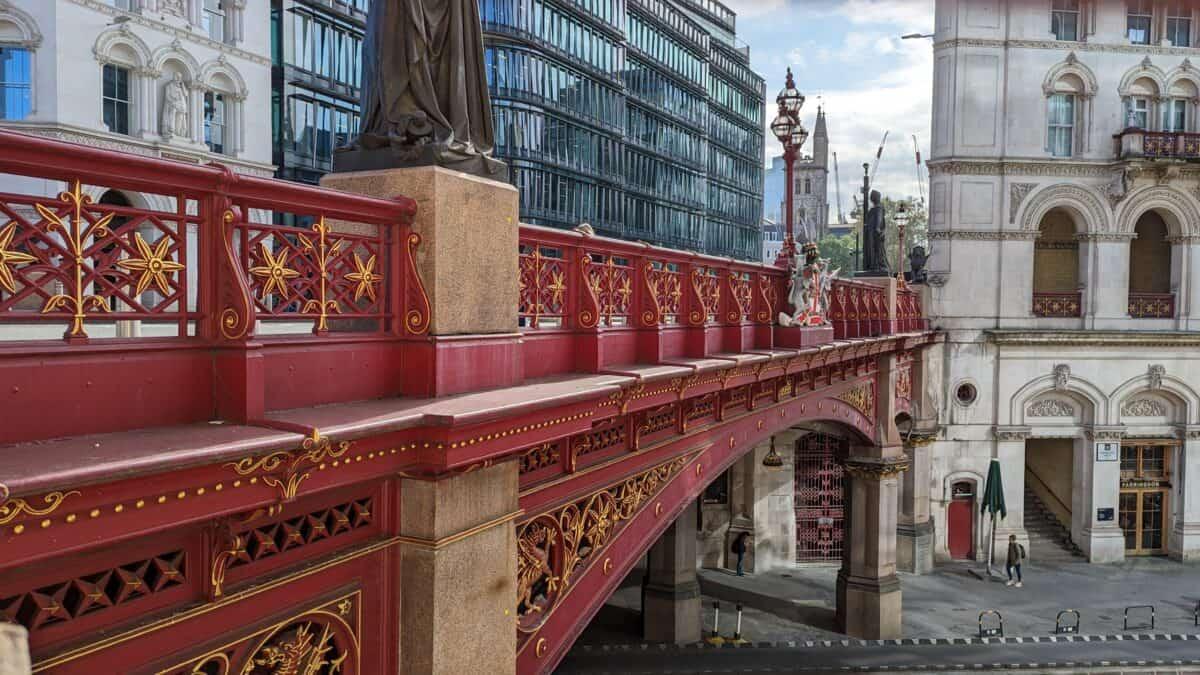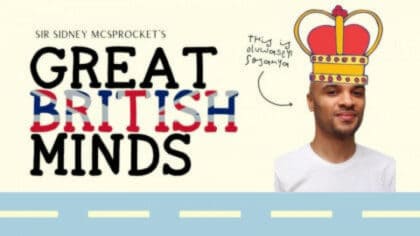The River Thames has been important to London for thousands of years – helping the city defend itself but more importantly being a route for trade.
Embed from Getty ImagesGetting from one side of the river to the other has always been important. London’s bridges aren’t just iconic parts of the city, they’re some of its most important assets. Every day, thousands of Londoners use them on their journey’s to and from school and work as well as sightseeing.
Blackfriars Bridge
Blackfriars Bridge links the City of London with the South Bank. It was named after a large monastery that once stood to the north of the Thames, that was until Henry VIII dissolved them in 1538. Like the monastery, the first bridge built here didn’t last too long.

The first Blackfriars Bridge was opened in 1769. It was designed by Robert Mylne in what was called the Italianate style. That’s a style known for its symmetry, ornate decorative detail and classical influences.
The bridge was built in Portland stone and had nine semi-elliptical arches. It wasn’t a strong bridge though. Workmanship was pretty bad and it needed lots of repairs. In 1860, they decided to demolish it and start again.
Embed from Getty ImagesThe bridge we see today is the second Blackfriars Bridge. It was opened in November 1869 by none other than Queen Victoria herself. Designed by Joseph Cubitt, it’s made up of five wrought iron arches and was originally a little narrower.
Embed from Getty ImagesAs London’s population grew, and more and more traffic needed to cross the river, the bridge was widened in 1910 to its current 32 metres.
Embed from Getty ImagesCan you see a row of red pillars in the river?
These supported the first Blackfriars Railway Bridge which was opened in 1864 by the London, Chatham and Dover Railway. Like the current road bridge, it was also designed by Joseph Cubitt.

When opened, a station called Blackfriars Bridge was on the southern bank, and the four-track bridge carried passengers across the river to a station called Ludgate Hill.
In 1886, a second railway bridge was opened, designed by John Wolfe-Barry and Henry Marc Brunel, and made of wrought iron. Originally called the St Paul’s Railway Bridge, it carried trains across the river into St Paul’s station on the north bank, a station that today is called Blackfriars.
Embed from Getty ImagesOver time, fewer trains used the first railway bridge and it fell into disrepair. It was removed in 1985 and all that remains are the red pillars and an abutment on the south side of the river, showing the railway’s colourful insignia. Nice safe places for us pigeons to have a sleep upon!
Embed from Getty ImagesWhen they changed the name of the railway station to Blackfriars in 1937, they also changed the name of the bridge. Today, it’s one of the only railway bridges in the UK that you can walk across, as Blackfriars station platforms now span the bridge, and the station has entrances on both sides of the Thames.
Millenium Bridge
Millenium Bridge is London’s most modern bridge and the first pedestrian bridge for over a century, linking Bankside with the City of London.
Embed from Getty ImagesWhen it opened in the year 2000, Londoners nicknamed it the “Wobbly Bridge” after people experienced an alarming swaying motion. It must have felt like walking the plank! Today it’s perfectly stable and a great place to watch things moving along the river.
The design is pretty cool and very modern. Designed by sculptor Anthony Caro, architects Foster & Partners and engineers, Arup, it’s described as an innovative blade of light.
Two Y-shaped armatures support eight cables that run along the sides of the deck, while steel transverse arms support the deck itself. It’s a ground-breaking design that gives it a very shallow profile, and ensures those crossing enjoy uninterrupted panoramic views.
Embed from Getty ImagesIt’s a bridge with a film career. It was in the opening scenes of Harry Potter and the Half-Blood Prince and also in Guardians of the Galaxy during a climactic battle on Xandar.
If you’ve got those films at home, why not watch them and see if you can spot the bridge!
Southwark Bridge
The next bridge is Southwark Bridge. The first Southwark Bridge was designed by John Rennie. Its official opening in 1819 was very exciting. It was held at midnight to promote an amazing new innovation, lighting provided by 30 gas lamps.
Whilst made of cast iron, it didn’t have the strength to carry heavy vehicles. The original bridge was demolished in 1913 and a new bridge, designed by architect Sir Ernest George and engineer Basil Mott, opened in 1921. It’s made up of cast iron arches with abutments and balustrades of grey granite. Its arches and piers are aligned with those on Blackfriars Bridge to ease the flow of the river.
Embed from Getty ImagesSeveral times in the 17th and 18th centuries, during very cold winters and because the many piers of London Bridge disrupted the flow of the river, the Thames sometimes froze over giving Londoners the opportunity not just to skate, but have festivals with food stalls, sporting events and even temporary pubs on the ice. You can check out a cool mural depicting the frost fairs on the north bank of Southwark Bridge, inside the pedestrian tunnel.
Embed from Getty ImagesFor movie fans, Southwark Bridge has also made a few film appearances, including Harry Potter and the Order of the Phoenix. Another one to look out for later!

Cannon Street Railway Bridge
Our next bridge is Cannon Street Railway Bridge.
Embed from Getty ImagesThis part of the Thames has a rich trading history all the way back to Roman times, loading and unloading goods from Britain and abroad.
Today Walbrook Wharf is one of London’s waste transfer stations, loading 50,000 of waste every year into barges which take it to Bexley. If you’re lucky, you may see some of the waste containers being loaded. Walbrook is also one of London’s hidden rivers, which we explore in another walk.

Cannon Street was built on a site of a medieval steelyard which operated from the 10th to 16th century. It was the trading base of Hanseatic merchants, a medieval guild of European traders. Just imagine the noise of all the metal workings.
Cannon Street station was built between 1863 and 1866 by South Eastern Railway who wanted a railway terminal in the City and to compete with their rivals, the London, Chatham and Dover Railway.

Cannon Street Bridge consists of five impressive spans supported by cast iron Doric pillars. The original bridge incorporated two footpaths, one for railway employees, the other for paying members of the public. The footpaths were removed in 1893 when the bridge was widened by adding four extra cast-iron cylinders to the upstream side of each pier.
Like other bridges we have seen, the bridge has been rebuilt over time. The two brick towers, though, date from the original bridge and conceal large water tanks to power Cannon Street station’s hydraulic lifts.
Embed from Getty ImagesCannon Street’s name is a shortening of the Middle English ‘candelwrichstrete’ which means ‘street of candle makers’ and was first mentioned in the 12th century.
London Bridge
Our next bridge is London Bridge, probably one of the most famous bridges in the world.
Embed from Getty ImagesThere’s been a bridge around here since Roman times, nearly 2,000 years ago. The first was probably a pontoon bridge built of wood, followed by a more substantial bridge as trade grew and a small trading settlement was established – the town of Londinium!
The settlement and bridge were destroyed in a revolt led by Queen Boudicca in 60 AD. Soon afterwards, the Romans set about building a new walled town and bridge, some of which has survived to this day.
Embed from Getty ImagesThe next significant bridge action was in the late 9th century when Saxons moved to settle in the area and a bridge was rebuilt by Alfred the Great only to be destroyed AGAIN in 1014 by Æthelred’s ally Olaf to divide the Danish forces who held both the walled City of London and Southwark.
Embed from Getty ImagesNo wonder the nursery rhyme talks about London Bridge falling down over and over again!
After the Norman conquest in 1066, King William I rebuilt the bridge, only for it to be replaced by King William II before being destroyed by fire in 1136 and then rebuilt in the reign of King Stephen.
In 1176, King Henry II commissioned a new stone bridge with a chapel at its centre dedicated to the martyred Thomas Becket. So down came the old and up went the new with 19 arches and a wooden drawbridge, opening in 1209.

Something that might be hard to imagine… there were houses, shops and even a church on the bridge, which was all quite normal and a good way to pay for bridge maintenance.
When London Bridge wasn’t being pulled down, it caught fire! In 1633, a fire destroyed houses on the northern part of the bridge, creating a firebreak that luckily prevented the 1666 Great Fire of London from spreading across the bridge into Southwark.

The Great Fire though did destroy the bridge’s waterwheels, preventing water from being pumped to fight the fire. In 1831, a new five stone arch bridge, designed by John Rennie, was opened 100 feet upstream of the medieval bridge, which was then demolished after 622 years of service.
The current London Bridge was opened by Queen Elizabeth II in 1973.
Embed from Getty ImagesIt comprises three spans of prestressed-concrete box girders. It was built in the same location as Rennie’s bridge, with the old bridge remaining in use whilst the new bridge was built around it.
The old bridge wasn’t thrown away, it was rebuilt stone by stone in Arizona USA.
Embed from Getty ImagesTower Bridge
The final London bridge is Tower Bridge, a bridge that’s instantly recognisable!

After eight years of construction under the watchful eye of Sir John Wolfe Barry, it opened in 1894 and is a quintessential image of London and the Victorian Era. It’s a drawbridge which allows ships to pass under the bridge deck when it’s raised in the centre.
Embed from Getty ImagesDid you know Queen Victoria was originally opposed to the building of Tower Bridge. She was concerned that it would compromise the security of the Tower of London. Maybe in a way to appease her, the bridge was originally painted in Queen Victoria’s favourite colour… chocolate brown.
The bridge is 800 ft long, with two towers built on piers.The drawbridge can be raised in 5 minutes by huge hydraulic pumps within the towers. The bridge contains more than 11,000 tons of steel and is covered with Cornish granite and Portland stone. The bridge still opens today to allow large ships to pass through, around 1,000 times a year.
Maybe you’ll be lucky to see this happening!
Embed from Getty ImagesHere’s a cool fact! Once it opened a bit too soon. In 1952, a bus had to make a jump for it when the bridge opened before the bus had time to cross.
Now, that would put everyone in a flap!
Add a commentLondon’s History
London has a rich and full history that we can't wait to tell you all about! From The Romans of Londinium to the Tudors of London, it's all here.
More From London’s History






